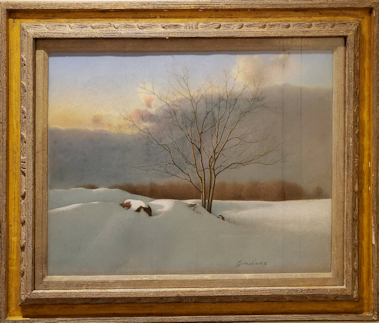|
|
|
|
|
Item #AT-0425Winter Landscape II by Werner Groshans NA, (1913-1986)
|
|
|
|
|
Description: Werner Groshans (1913-1986)
Winter Landscape II
Pastel on Paper
18.75” x 24.5” Unframed
27.5” x 33.5” Framed
Signed lower right
Circa 1979
Provenance:
Babcock Galleries, NYC
Robert A. Jones, Montclair NJ
Estate of Robert A. Jones
Stillwell House Fine Art & Antiques, NJ
Exhibition History:
1987 Jersey City Museum, titled Winter Landscape II
1987 New Jersey State Museum, titled Catskill Landscape II
1987 New Jersey State Museum, Winter Landscape II
|

|
|
|
|
Werner Groshans NA, (1913-1986)
Groshans's father, a jewelry designer, came to Newark, New Jersey, in 1926, the family joining him a year later. After graduating from high school, he entered the Newark School of Fine and Industrial Arts. His principal teacher was Bernar Gussow, who passed on the post impressionist aesthetic of his teacher, Pierre Bonnard.
Groshans, who completed his studies at the Newark School in 1934, admired Gussow, but could not accept the style of his teacher. Instead, he formed his art from intense study of the Old Master paintings in the Metropolitan Museum of Art; the technical aspect of the work of Salvador Dali, seen in a New York gallery exhibition, made a strong impression.
|
![]()
|
|
|
|
|
From 1938 to 1940 Groshans worked for the Newark project of the Works Progress Administration. During World War II, he worked in a radio assembly plant, having been rejected for military service for health reasons, but continued painting in his spare time. In 1944 he married, moved into Manhattan, and began a pattern of holding an income-producing job several days a week and otherwise working at his painting; he finally turned all his time and attention to painting in 1945. Recognition began to come in the last years of the 1940s, when Groshans was selected for New York's Whitney Museum of American Art's annual exhibitions in 1948 and 1949, and a contemporary exhibition organized by the Metropolitan Museum, 1950.
|
![]()
|
|
|
|
![]()
|
In 1953, he moved to Catskill, New York, where he lived and worked to 1957. Groshans then returned to New Jersey, locating in Weehawken, which remained his home until the year before his death. Although his paintings were seen, and acquired by museums, throughout the country, he maintained a strong identification with New Jersey. He was a member of the Associated Artists of New Jersey, and one of its directors, 1965-67; chairman of the Fine Arts Department, Jersey City Museum, 1966-69; New Jersey Artist of the Year in 1966. The Painters and Sculptors Society of New Jersey, of which he was also a member, presented him with its Tercentenary Award. Groshans's landscapes, still lifes, figures, and portraits, executed in oils and pastels, were commonly termed Surrealist, because of the mysterious selectivity in their subject elements, and the eerie stillness of atmosphere.
|
|
|
|
![]()
|
The artist's intention was quite distinct from those of painters of dream images: "What interests me is the mysterious element that really does exist in nature, sometime in the most commonplace objects and situations--that magic moment that makes an unexplainable experience linger in your memory." (Dulac, 74)
Among Groshans's awards were the Thomas B. Clarke Prize conveyed by the Academy in its annual exhibition of 1960. He served on the Academy Council from 1970 to 1973. The Babcock Gallery, New York, represented the artist from 1973. His works can be found in many important Museums and institutions including The Smithsonian American Art Museum, National Academy of Design.
|
|
|
|
|
|
|
|
|
|
|
|
|
|
|
|
|
|
|
|
|
|
|
|
|
|
|
|
|
|
|
|
|
|
|
|
|
|
|
|
|
|
|
|
|
|
|
|
|
|
|
|
|
|
|
|
|
|
|
|

